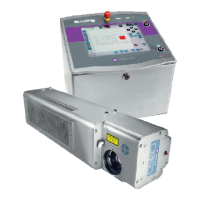Pre-Installation Installation Training
A70622-D1
95/192
Adjusting laser settings according to substrate
It is recommended to use the static marking mode to test the substrate reaction and adjust
laser settings to reach the expected result.
Power and Energy density
To evaluate marking capabilities of a coding laser to mark on a substrate, we use to speak about
energy density and not power.
Energy density (E) is the energy given by the power concentration at the focus point. At this point
and for a given laser power (P), the energy density is maximum for the smallest laser beam
section. Unit = Joules/ square meter (J/m²).
The size of the laser beam section depends on the beam quality generated by the laser source and
the optical system mounted. Because it is question of surface, the energy density varies in a
proportional square rule according to beam diameter variations.
For a given laser power (P), the energy density can be chosen by selecting the appropriate lens
mounting onto the scanning head. Note that, the choice of the lens may also affect the speed
capabilities through its associated marking field.
Laser settings
Duty
Increasing the duty allows to get a deeper mark on the substrate. It is just activating the laser beam
more or less longer into a frequency period.
> This parameter doesn’t affect the marking speed performance
Frequency
Increasing the frequency will generate closer laser impacts on the substrate. It may be useful to
reduce the frequency when marking on substrate which tends to melt like PET in order to get
thinner lines and control the mark depth.
> This parameter doesn’t affect the marking speed performance
Marking speed
Marking speed (ms) is the speed of the laser beam when it draws the characters. The faster is the
marking speed, the shorter is the time to mark, but the less is the quality of the mark.
> This parameter strongly affects the marking speed performance = directly linked to the
marking time.

